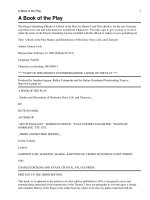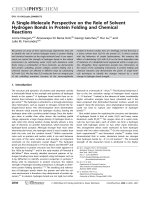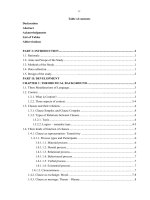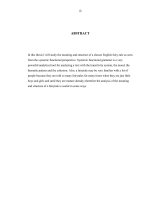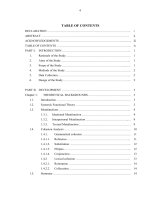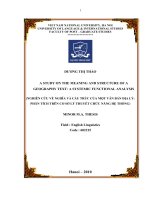A systemic funtional perspective on the meaning and structure of the story the selfish giant by oscar wilde
Bạn đang xem bản rút gọn của tài liệu. Xem và tải ngay bản đầy đủ của tài liệu tại đây (575.08 KB, 143 trang )
VIETNAM NATIONAL UNIVERSITY, HANOI UNIVERSITY OF LANGUAGES AND
INTERNATIONAL STUDIES DEPARTMENT OF POST – GRADUATE STUDIES
ĐÀO THỊ MINH TÂN
A SYSTEMIC FUNCTIONAL PERSPECTIVE ON
THE MEANING AND STRUCTURE OF THE STORY
“THE SELFISH GIANT” BY OSCAR WILDE
BÌNH DIỆN NGỮ PHÁP CHỨC NĂNG HỆ THỐNG VỀ CẤU TRÚC
VÀ NGỮ NGHĨA CỦA TRUYỆN NGẮN “GÃ KHỔNG LỒ ÍCH KỶ”
CỦA OSCAR WILDE
M. A. MINOR THESIS
Field: English Linguistics
Code: 60 22 15
HANOI, 2011
VIETNAM NATIONAL UNIVERSITY, HANOI UNIVERSITY OF LANGUAGES AND
INTERNATIONAL STUDIES DEPARTMENT OF POST – GRADUATE STUDIES
ĐÀO THỊ MINH TÂN
A SYSTEMIC FUNCTIONAL PERSPECTIVE ON THE
MEANING AND STRUCTURE OF THE STORY “THE
SELFISH GIANT” BY OSCAR WILDE
(BÌNH DIỆN NGỮ PHÁP CHỨC NĂNG HỆ THỐNG VỀ CẤU TRÚC
VÀ NGỮ NGHĨA CỦA TRUYỆN NGẮN “GÃ KHỔNG LỒ ÍCH KỶ”
CỦA OSCAR WILDE)
M.A MINOR THESIS
Field: English Linguistics
Code: 60 22 15
Supervisor: Prof. Dr. Hoàng Văn Vân
Hanoi, 2011
iv
TABLE OF CONTENTS
DECLARATION …………………………………………………………….
i
ABSTRACT ……………………………………………………………
ii
ACKNOWLEDGEMENT …………………………………………………. ..
iii
TABLE OF CONTENTS ……………………………………………….
iv
LIST OF TABLES ……………………………………………………………
vii
CHAPTER I: INTRODUCTION
1
1. Rationale of the study........................................................................................................ 1
2. Aims of the study................................................................................................................ 1
3. Scope of the study............................................................................................................... 2
4. Methods of the study.......................................................................................................... 2
5. Design of the study............................................................................................................. 2
CHAPTER II: LITERATURE REVIEW
3
1. Introduction............................................................................................................................ 3
2. Theories of systemic functional grammar....................................................................... 3
2.1. The Transitivity structure …………………………...................................
4
2.1.1. Material processes......................................................................................................... 5
2.1.2. Relational processes: …………………….......................................................... 6
2.1.3. Mental processes………..........................................................................
7
2.1.4. Verbal processes…...................................................................................
7
2.1.5. Behavioural processes................................................................................................... 8
2.1.6. Existential processes..................................................................................................... 9
2.1.7. Circumstances: ……………………………………........................................... 10
2.2. The Mood structure........................................................................................................... 11
v
2.3. The thematic structure …………………………........................................
12
2.4. Cohesion ………………............................................................................................. 18
2.4.1. Grammatical cohesion.................................................................................................. 18
2.4.1.1. Reference………..…….................................................................................... 18
2.4.1.2. Conjunction………................................................................................................... 19
2.4.1.3. Ellipsis……………................................................................................................... 19
2.4.1.4. Substitution:................................................................................................................. 19
2.4.2. Lexical Cohesion........................................................................................................... 20
2.4.2.1. Repetition................................................................................................................... 20
2.4.2.2. Synonymy.................................................................................................................. 20
2.4.2.3. Antonymy……........................................................................................................... 21
2.4.2.4. Hyponomy.................................................................................................................... 21
2.4.2.5. Meronymy.................................................................................................................... 21
2.4.2.6. Collocation................................................................................................................... 21
CHAPTER
III:
THE
MEANING
AND
STRUCTURE
OF
THE
STORY
“THE SELFISH GIANT”
1. Introduction............................................................................................................................ 22
2. The Context of the Chosen Text........................................................................................ 22
3. Clauses and Clause Complexes......................................................................................... 22
4. The analysis of the text in terms of Transitivity, Mood and Theme..........................23
4.1.The Transitivity Pattern..................................................................................................... 23
4.2.The Mood Pattern............................................................................................................... 25
4.3.The Theme – Rheme Pattern............................................................................................ 26
5. The Cohesion of the Text.................................................................................................... 27
vi
5.1. Grammatical Cohesion..................................................................................................... 27
5.1.1. Reference......................................................................................................................... 27
5.1.2. Conjunctive Devices..................................................................................................... 31
5.1.3. Substitution………….................................................................................
32
5.2. Lexical Cohesion............................................................................................................... 32
5.3. Contextual Configuration of the text............................................................................ 38
CHAPTER IV: CONCLUSION
40
4.1. Recapitulation.................................................................................................................... 40
4.2. Implication of the Paper................................................................................................... 40
4.3. Suggestions for Further Study........................................................................................ 41
References ………………………………………………………………………. 42
Appendix 1 ……………………………………………………………………..
I
Appendix 2 ………………………………………………………………….. …
VI
Appendix 3 ……………………………………………………………………..
XIII
Appendix 4 ……………………………………………………………………..
XIX
Appendix 5 ……………………………………………………………………..
XXIV
Appendix 6 ……………………………………………………………………..
XXIX
Appendix 7 ……………………………………………………………………..
XXXIX
vii
LIST OF TABLES
Table A: Process types, Category meaning, and key participants
Table B: The main types of circumstances and their features
Table C: Themes and features
Table 1: Clause and Clause Complexes Analysis
Table 2: Clause and Clause Complexes relationship
Table 3: Transitivity pattern of the text
Table 4: the Mood pattern of the text
Table 5: The Thematic pattern of the text
Table 6: Grammatical Cohesive Devices of the Text
Table 7: The analysis of the text in terms of Transitivity, Mood and Theme
1
CHAPTER I: INTRODUCTION
1. Rationale
There are many grammatical paradigms and each of them views language from different
perspectives. And among those, systemic functional grammar is a very new trend which has not
been known much in Vietnam. Up till now, there have been only two works which study
functional grammar. The first is Tiếng Việt – Sơ thảo ngữ pháp chức năng by Cao Xuân Hạo
(1991) and the second is Ngữ pháp kinh nghiệm của cú Tiếng Việt – mô tả theo quan điểm chức
năng hệ thống by Hoàng Văn Vân (2002). Both of them have contributed much to the study of
this field and brought the paradigm which has not yet been highlighted in Vietnamese schools
closer to Vietnamese learners.
In contrast to traditional grammars that place importance on language form, systemic functional
grammar (SFG) emphasizes how language is used to express meaning i.e. it focuses on the
functions of language. Moreover, SFG interprets language as interrelated sets of options for
making meaning and seeks to provide a clear relationship between functions and grammatical
systems (Halliday, 1994). It is closer to our language in daily life, and thus can help us to see and
understand human language more deeply and comprehensively. It can be said without
exaggeration that functional grammar is „an effective tool of analysis, which solves the issues
left out by traditional grammar‟. In addition to that, functional grammar also offers us an
analytical tool of looking at the whole text and the grammatical features which are typical
characteristic of that kind of text. For the above-mentioned reasons, I have decided to choose “A
systemic functional perspectives on the meaning and structure of the story „The selfish Giant‟
by Oscar Wilde” as the topic of my thesis, using Halliday‟s functional grammar as the theoretical
framework.
2. Aims of the study
Within the framework of the paper, the study attempts to:
Re-examine some of the most important issues related to the experiential,
interpersonal and textual aspect of language.
Analyze the meaning and structure of the story “The selfish Giant” by Oscar
Wilde based on the systemic functional module.
2
3. Scope of the study
The study does not attempt to cover all aspects of functional grammar but limits itself to
some main areas of functional grammar. In other words, only issues relating to the analysis of the
text are taken into consideration. These are transitivity structure, mood structure, theme – rheme
system and cohesion. The text used for illustration is the short story “The selfish Giant” by Oscar
Wilde.
4. Methods of the study:
The aim of this paper is to analyze the meanings and structures of a short story. Therefore,
description and analysis are the principle methods of the study. The descriptive method is
concerned with the description of main areas of functional grammar. The analytic method is
concerned with the analysis of the text.
5. Design of the Study
The paper is designed in four chapters
Chapter one: Introduction – presents the rationale of the study, the aims of the study,
scope of the study, methods of the study and the research design of the study.
Chapter two: Literature review – provides some fundamental and theoretical concepts
for
the study: systemic functional theory, metafunctions, and cohesion analysis.
Chapter three: The study of the text “The selfish Giant” focuses on the meaning and
structure of the text.
The last chapter: Conclusion – summarizes the results of the study.
3
CHAPTER II: LITERATURE REVIEW
1. Introduction
This chapter attempts to provide a theoretical orientation for the study. We shall be
concerned with systemic functional theory and some features of systemic functional grammar. In
addition, we shall present briefly three components of meaning in language and cohesion
analysis.
2. Theories of Systemic Functional Grammar
Systemic functional grammar is a grammar model developed by M.A.K. Halliday (1994)
which takes a functional approach to grammar, analyzing language as a social-semiotic of
communicative meaning-making. Language and interaction are defined by context and this
model seeks to show how contextual meaning is expressed in grammar. SFG is „systemic‟ in that
grammar consists of a series of choices that can be made in order to express ideas; in other
words, language represents a system network within which language choices are meaningful in
relation to other choices that are suppressed. It is „functional‟ in that the systems achieve certain
functions which are realized in the lexico-grammar of the language.
There are three „metafunctions‟ which form the basic foundation on which systemic
functional grammar (SFG) is based. These functions are labelled as ideational; interpersonal,
and textual. Each of the three metafunctions is about a different aspect of the world, and is
concerned with a different mode of meaning of clauses. While all three metafunctions act
together to produce meaning, in SFG they each have their own grammatical system.
The ideational metafunction consists of the experiential and logical metafunction. The
experiential metafunction is about the natural world, that means it shows the way
language is used to express our perception of the world, and explains how we use
language to describe
„doings‟ and „happenings‟. Experiential metafunction is concerned with clauses as
representation. The experiential metafunction reflects the field parameter of register. Experiential
meanings are realized through the system of TRANSITIVITY which is realized as „processes‟ in
a verb phrase constituent and its associated participants.
The interpersonal metafunction is about the social world, especially the relationship
between speaker and hearer, and is concerned with clauses as exchange. As Halliday
(1994: 68)
puts it: “The most fundamental types of speech role, which lie behind all the more specific types
that we may eventually be able to recognize, are just two (i) giving, and (ii) demanding”. This
4
means there are two roles in exchange: giving and demanding. He goes on to analyze the nature
of the commodity being exchanged into (a) goods-and-service and (b) information. The MOOD
realizes this metafunction and elements of modality, tense and polarity are taken into account.
The textual metafunction is about the verbal world, especially the flow of information in
a text. It organizes clauses as messages realized by speakers who arrange the ways in
which the various groups and phrases in the clause are ordered with the THEME system.
The THEME system includes Theme and Rheme. The Theme is the element which serves
as the point of departure of the message, and the Rheme is the part in which the Theme is
developed.
2.1. The Transitivity structure
Transitivity is the semantic category which expresses what the clause is about. In
Halliday‟s terms, transitivity is a part of the ideational function of the clause. The ideational
function of the clause is concerned with the “transmission of ideas.” Its function is that of
“representing „processes‟ or „experiences‟: actions, events, processes of consciousness and
relations” (1985:53). The term “process” is used in an…extended sense, “to cover all
phenomena…and anything that can be expressed by a verb- event, whether physical or not, state,
or relation” (Halliday, 1976:159). Halliday further notes that the “processes” expressed through
language are the product of our conception of the world or point of view. He notes “Our most
powerful conception of reality is that it consists of “goings-on”: of doing, happening, feeling,
being. These goings-on are sorted out in the semantic system of the language, and expressed
through the grammar of the clause… The clause evolved simultaneously in another grammatical
function expressing the reflective, experiential aspect of meaning. This…is the system of
TRANSITIVITY. Transitivity specifies the different types of process that are recognized in the
language, and the structures by which they are expressed (Halliday, 1985:101)”
Transitivity processes can be classified into material, relational, mental, verbal, behavioral, and
existential processes, according to whether they represent processes of doing, being, sensing,
saying, behaving, or existing, respectively.
All types of processes are subsumed under the basic semantic framework consisting of
three components:
i)
the process itself, which will be expressed by the verb phrase in a clause.
ii) the participants in the process, which refer to the roles of entities that are directly
involved in the process : the one that does, behaves or says, together with the passive one
that is
5
done to, said to, etc. The participants are not necessarily humans or even animate; the term
“participant entities” would be more accurate (Halliday, 176:160). The participant entities are
normally realized by noun phrases in the clause.
iii)
the circumstances associated with the process, which are typically expressed by
adverbial and prepositional phrases.
This framework has the potential of interpreting one's experience of reality. That is the
speaker's/writer's experience of the external world and the world of his consciousness. So, clause
as process has the function of expressing what reality is all about. This is semantically
categorized as process of doing, happening, feeling etc.
The following sections account for these major processes realized in the transitivity system, and
the participant roles that are involved in the processes.
2.1.1. Material processes
Material processes are processes of doing in the physical world. The basic meaning of the
material process is that some entity does something, undertakes some actions. One identification
criteria for material process is that they can be probed by the question “What did X do?”
Material processes have two inherent participants involved in them. The first of these is the
Actor, which is an obligatory element and expresses the doer of the process. The second is the
Goal, which is an optional element and expresses the person or entity (whether animate or
inanimate) affected by the process.
The following examples illustrate these constructions:
John
John
The boat
Actor
Material processes take the third participant. It is called Receiver – the one that benefits from the
process. For example:
He
Actor
Of course, it is possible to reverse Actor- Goal in a passive form, placing a Goal at an initial
position and Actor at the end of the sentence, such as:
The man
6
Goal
2.1.2. Relational processes
Relational processes are concerned with the process of being, being at, and having.
Normally, a relationship that exists between two participants associated with the process is
considered, but unlike the case of material process, a participant does not affect the other
participant in a physical sense.
The types of relational process are quite complex and controversial. The type comes under three
subtypes (i) intensive (ii) possessive and (iii) circumstantial.
Intensive expresses an “x is y” relationship, one is the other – the relationship
between the two terms is one of sameness.
Circumstantial denotes an “x is at y” relationship, – the relationship between the
two terms is one of time, place, manner, cause, accompaniment, matter or role.
Possessive, an “x has y” relationship - the relationship between the two terms is
one of ownership, one entity possesses another.
Each of the three types can appear in two distinct modes: Attributive and Identifying.
i)
Attributive mode: “y is an attribute of x”
In the attributive mode a qualitative attribute is assigned to an entity. The structural elements
expressing this mode of process are Attribute and Carrier. The Carrier is always realized by a
noun or a nominal phrase, and the Attribute by an adjective or a nominal phrase The attribute
may be ascribed as a quality (intensive), and as a circumstance (circumtantial), or as a
possession (possessive);
For example:
John
John
Carrier
ii) Identifying : “y is the identity of x”
In the identifying mode, one entity is used to identify another. The relationship between
them varies according to the type of relation process: Token and Value (intensive), of
7
phenomenon and circunstance of time, place etc. (circunstantial), or owner and possession
(possessive). The structural function of the participants in each case are Identified and Identifier.
The identifying process is reversible, because the identifying process involves two independent
nominal participants.
For example:
She
Identified / Token
2.1.3. Mental processes
Mental processes encode the meanings of feeling or thinking. Mental processes are
“internalized” processes. Grammatically, all mental processes involve two participants:
Senser - the conscious being who is involved in a mental process by feeling, thinking, or
perceiving and Phenomenon which is felt, thought, or perceived by the conscious Senser.
Mental process verbs can be subcategorized into three types:(l) perception (sensing, hearing,
seeing etc.), (2) affection (liking, loving, fearing etc.) and (3) cognition (thinking, knowing,
understanding etc.)
Examples of each type are as follows.
Cognition
Affection
Perception
2.1.4. Verbal processes
Verbal processes are processes of saying, and it exists on the borderline between mental
and relational processes. Just like saying and meaning, the verbal process expresses the
relationship between ideas constructed in human consciousness and the ideas enacted in the form
of language (Halliday, 1994:107). Examples of verbal processes are “I said I am happy” and
“The chairperson calls for the meeting.” Note that “saying” is used in an extended sense and the
“speaker” need not be a conscious being (unlike a Senser in mental process), hence a verbal
process includes any kind of exchange of meaning, such as “The booklet tells you how to find a
job” or “The clock says it is ten.” The participant who is speaking is called Sayer, the addressee
to whom the process is directed is Target, and what is said is Verbiage, for example:
I
an
Sayer
Pr
I
to
Sayer
Pr
The element “what is said” may be either directly quoted or indirectly reported.
He
He
Sayer
2.1.5. Behavioural processes
Behavioural processes are processes of physiological and psychological behaviours, and
they are on the borderline between material and mental processes. Behavioural processes
“represent outer manifestations of inner workings, the acting out of processes of consciousness
and physiological states” (Halliday, 1994:107). Behavioural processes are the least salient of
Halliday‟s six process types, and the boundaries of behavioural processes are indefinite. The
participant who is behaving is called Behaver. Like the Senser, Behaver is usually a conscious
being, but the process is more like one of doing, as in material processes. For example:
John
Behaver
George
Behaver
Some other examples of behavioural processes are sit, dance, sing, lie (down) (near material
processes), think, watch, look, listen (near mental processes), talk, gossip, grumble, chatter (near
verbal processes), smile, laugh, cry, frown (physiological processes expressing states of
consciousness), sleep, breathe, cough, yawn (other physiological processes) (Halliday,
1994:139).
2.1.6. Existential processes
Existential processes are processes of existing and happening. While existential clauses are not
very common in discourse, they make an important, specialized contribution to various kinds of text.
Existential sentences typically have the verb „be‟, and the word „there‟ is necessary as a
9
Subject although it has no representational function. Frequently an existential clause contains a
distinct circumstantial element of time or place. The object or event that is being said to exist is
called Existent. An Existent can be any kind of phenomenon, such as a thing, person, object,
institution or abstraction, action, or event.
For example:
There
The writer has discussed all the types of processes in details. The summary of the types of
process together with their general category meaning and the principal participant functions that
are associated with each will be shown in the table below.
Process type
1.
Material:
Action
Event
2.
Behavioral
3.
Mental:
Perception
Affection
Cognition
4.
Verbal
5.
Relational:
Attribution
Identification
6.
Existential
Table A: Process types, Category meaning, and key participants
(Source: Halliday, 1994: 143)
2.1.7. Circumstances
This element functions to provide more information about circumstances in which
participants take part in the process. It adds meaning to a clause by describing the context within
which the process takes place.
10
Circumstance is realized by adverbial groups, prepositional phrases or nominal groups.
Circumstantial elements lie at the end of the continuum and they occur in all types of process and
with the same significance wherever they occur.
Circumstance expresses supplementary information, such as place, time, extent, matter, manner,
duration, condition, means, etc.
The main types of circumstances and their features are shown in the table below:
Type
Extent
Location
Manner
Cause
Contingency
Accompaniment
Role
Matter
Angle
Table B: The main types of circumstances and their features
(Source: Halliday 1994: 151)
Here are some examples of the use of circumstances.
•
Ali had slept in the car. (location,place)
• See you in the morning (location,time)
•
They pulled the ropes again (extent frequency)
• He pleased her with his gift (means, manner)
11
•
She has lived here for eight years (temporal, extent)
2.2. The Mood structure
The mood structure is responsible for the organization of the clause as an interactive
event which involves the speaker/writer and the listener/reader. It is the mood that expresses the
speech role the speaker/writer adopts for himself. By doing so the speaker/writer also assigns the
role the listener/reader is supposed to assume to complement the interactive event. In an
interactive event the speaker will be either giving information or demanding information. Giving
and demanding are defined according to the nature of their commodity exchange: 'goods-&service' for offer and command and 'information' for statements and questions. In 'goods- &service' the commodity exchanged is strictly non-verbal: what the speaker/writer demands is an
object or action. In this case language is just a means to achieve an end. For example: Bring me
the book or Do your homework first. According to Halliday ( 1985.p.70-71) because the
commodity exchanged in 'goods & service' cannot be affirmed or denied they are not
proposition, so he prefers to label this type of exchange as 'proposal'. 'Proposition' stands for the
exchange of information in which case language is the end as well as the means, and the answer
is always a verbal one. As stated by Halliday, propositions can be affirmed or denied, doubted,
contradicted, insisted on and so forth
Choices in the mood structure realizes the expression of mood in the clause and the mood
component is comprised of the mood element and the residue.
The mood element consists of two parts: The subject which is a nominal group and the
finite element which is part of a verbal group. The subject is the entity about which the
proposition is made. It is the subject which is held responsible for the clause as exchange. The
finite element has the function of making the proposition finite, it relates the proposition to the
context in the speech event. This may be done either by reference to the time of speaking,
primary tense, in which case it is expressed by means of a modal operator. So, the verbal
operator expressing finiteness is either temporal or modal. Besides expressing tense and
modality, the finite element also expresses polarity, the semantic category specifying whether
something is either positive or negative.
In English, the subject plus the finite element are responsible for the indicative, the grammatical
category which functions as general principle behind the expression of mood. That is, within
12
indicative the order of the subject and the finite element is what in English determines the role
the speaker and listener have in the exchange of information. This is expressed as follows:
a) Subject before Finite realizes 'declarative‟
b) Finite before Subject realizes yes/no interrogative
c) In WH-interrogative
i)
Subject before Finite if the WH-element is the Subject,
ii) Finite before Subject otherwise.
The Residue is the element in the mood structure which expresses the remaining part of the
clause. It consists of three elements: the Predicator, the Complement and the Adjunct.
-
The function of the predicator is fourfold: (i) It specifies time reference other than
reference to the time of the speech event. (ii) It specifies various other aspects and phrases like
seeming, trying, hoping. (iii) It specifies the voice (active or passive). (iv) It specifies the process
that is predicated of the Subject.
-
Complement: A Complement is an element within the Residue that has the potential of
being Subject but it is not. It is typical realized by a nominal group.
-
Adjunct: An Adjunct is an element that has not got the potential of being Subject. It is
typically realized by an adverbial group or a prepositional phrase.
She
Subject
Mood
They
Subject
Mood
2.3. The thematic structure
The three systems expressing the major categories of the semantic system have the clause
as entry condition. So, they describe the text in the light of its function in the structure of the
clause. The thematic structure is responsible for the organization of the clause as message. It
consists of two elements: Theme and Rheme. Theme functions as the „starting point for the
message‟ (Halliday, 1985a: 39), the element which the clause is going to be „about‟ has a crucial
13
effect in orienting listeners and readers. Theme is the starting point of the clause, realised by
whatever element comes first. Rheme is the rest of the message, which provides the additional
information added to the starting point and which is available for subsequent development in the
text. The Theme and the Rheme are responsible for the organization of the clause as
communicative event. Hence, the thematic structure is the category which gives the clause its
character as message.
The different choice of Theme has contributed to a different meaning and English uses first
clausal position as a signal to orient a different meaning of the sentences. For example:
An
A very good book,
Last night
What An read
An,
Theme
In each case above, the writer starts the message from a different point, that is, to choose a
different Theme for the clause. And also, the different choice of Theme has contributed to a
different meaning. What makes these sentences different is that they differ in their choice of
theme and they tell us what An, A very good book, Last night, What An read is going to be about.
The Theme may be expressed as follows:
2.3.1. Simple Theme
Simple theme contains only topical theme which expresses the main topic of the clause.
Simple theme can be expressed by one constituent which may be a nominal group, adverbial
group or prepositional phrase. For example:
On the wall
The man in the wilderness
Very carefully
Theme
Theme can also be represented by two or more groups or phrases forming a 'complex' (group
complex or phrase complex).
The Walrus and the carpenter
Tom, Tom, the piper‟s son
Theme
When the thematic structure is represented by two or more elements which are explicitly grouped
within the clause to form a single constituent of the thematic structure, we call it Thematic
equatives. This element is typically the Theme but it may function as Rheme.
For example:
What the duke gave to my aunt
The one who gave to my aunt that teapot
The way Mary washed her children‟s face
Theme
2.3.2. Multiple Themes
From the Theme theory, the first position in the clause is important and the kernel sentence
structure may be altered to bring elements to the front of the sentence when the speaker or writer
decides where to start the sentence and the beginning of each sentence is its theme. In English
three possible themes are found: Textual theme (discourse markers and conjunctions); +
Interpersonal theme (vocatives); + Topical theme (SVOA elements). And this clause is said to
have multiple Themes.
-
Textual theme, functioning to relate the meaning of the particular clause to other parts of
the text;
Interpersonal theme, often functioning to code the speaker‟s or writer‟s
personal
judgement on meaning;
Topical theme, functioning as the point of orientation for the experiential meanings
of the
clause;
Textual
15
Interpersonal
Experimental
Below are some examples of multiple theme:
Oh
continuative
textual
Theme
16
Please
modal
interpersonal
Theme
On the other hand
conjunctive
textual
Theme
2.3.3. Theme in clause complexes
We have known the position of themes in single clauses and now we will have a look at
themes in clause complexes, clauses consisting more than one clause. Let‟s take the following
sentence as an example:
As the universe expanded, the temperature of the radiation decreased.
There are two different ways of analysing of the dependent clause and each captures
different aspect of what is going on.
As the universe
Theme
Theme
2.3.4. Theme and Mood
The choice of Theme depends on the choice of Mood.
2.3.4.1. Theme in declarative clauses:
i)
Unmarked Theme - the Theme is conflated with
the Subject. E.g:
The two Indians stood waiting.
The Indian who was rowing them was working very
hard. Of course it's an accident.
ii) Marked Theme - In this case, the theme is something other than the subject. It may be an
adverbial group or a prepositional phrase which function as adjunct in the clause. The most
marked type of theme is said to be the one functioning as complement.
E.g:


